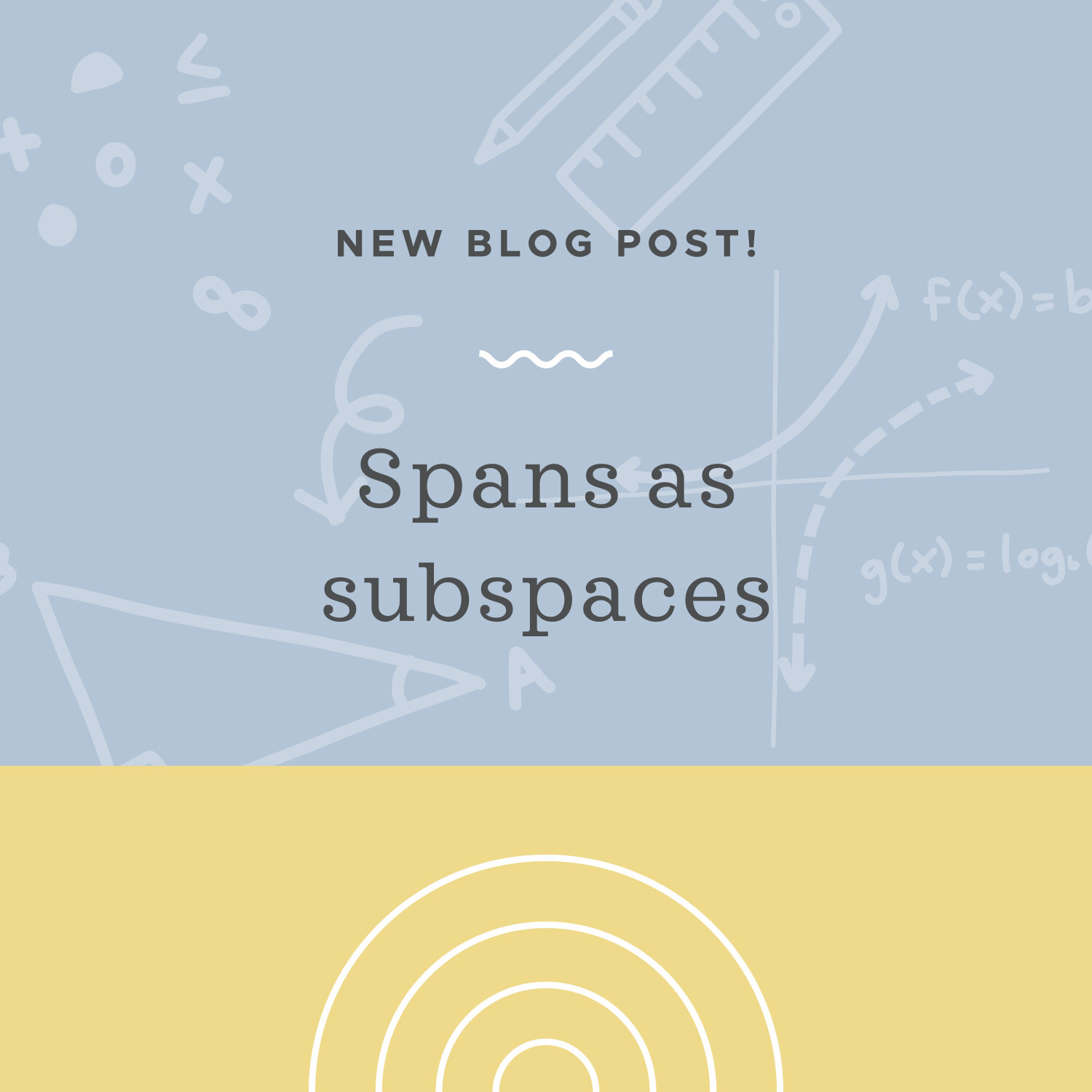A span is always a subspace
A span is always a subspace
In the last lesson, we looked at the possible subspaces that can exist in ???\mathbb{R}^2??? and ???\mathbb{R}^3???.
Hi! I'm krista.
I create online courses to help you rock your math class. Read more.
We said that ???\mathbb{R}^2??? itself, any line through ???(0,0)???, and the zero vector ???\vec{O}=(0,0)??? are all subspaces of ???\mathbb{R}^2???.
And we said that ???\mathbb{R}^3??? itself, any line through ???(0,0,0)???, any plane through ???(0,0,0)???, and the vector ???\vec{O}=(0,0,0)??? are all subspaces of ???\mathbb{R}^3???.
With this pattern in mind, we can conclude that every span is a subspace.
Spans are always subspaces
Remember that the span of a vector set is all the linear combinations of that set. The span of any set of vectors is always a valid subspace.
How to prove that a spanning set is always a subspace
Take the course
Want to learn more about Linear Algebra? I have a step-by-step course for that. :)
Showing that the vector set, defined by a span, is a subspace
Example
Show that the vector set ???V??? is a subspace.
???V=\text{Span}\left(\begin{bmatrix}2\\ 1\end{bmatrix}\right)???
We know that the span of a set of vectors is all of the linear combinations of the vectors in the set. In the set ???V??? we only have one vector, so all the linear combinations of the set will only be combinations of the single vector.
You can multiply ???\vec{v}=(2,1)??? by any scalar, and/or add and subtract any number of these same vectors, and you’ll still get a vector that falls only the same line as the original vector, namely ???y=(1/2)x???.
To show that the span represents a subspace, we first need to show that the span contains the zero vector. It does, since multiplying the vector by the scalar ???0??? gives the zero vector.
Second, we need to show that the span is closed under scalar multiplication. But as we already know, if we multiply the given vector by any scalar, we’ll still get a vector that’s included in the span, since the resulting vector will still lie along ???y=(1/2)x???.
Third, we need to show that the span is closed under addition. Let’s imagine that we have a linear combination like this:
???c_1\begin{bmatrix}2\\ 1\end{bmatrix}+c_2\begin{bmatrix}2\\ 1\end{bmatrix}+c_3\begin{bmatrix}2\\ 1\end{bmatrix}???
Remember that the span of a vector set is all the linear combinations of that set. The span of any set of vectors is always a valid subspace.
We can factor out the vector, and rewrite the sum (the linear combination) as
???(c_1+c_2+c_3)\begin{bmatrix}2\\ 1\end{bmatrix}???
The constant ???(c_1+c_2+c_3)??? is still just a constant, which means we could rewrite the linear combination as
???c_4\begin{bmatrix}2\\ 1\end{bmatrix}???
This result is still just a linear combination of the vectors in the set, which means it’s still contained within the span. Therefore, the set is closed under addition.
Because the vector set, which is the span of the single vector, includes the zero vector, is closed under scalar multiplication, and is closed under addition, the span is a subspace.
We can also say that, since the vector set is a line that passes through ???(0, 0)???, it’s a subspace of ???\mathbb{R}^2???.
The same logic we used in this example to show that the span was a subspace is a process we can use to show that any span is a subspace.







